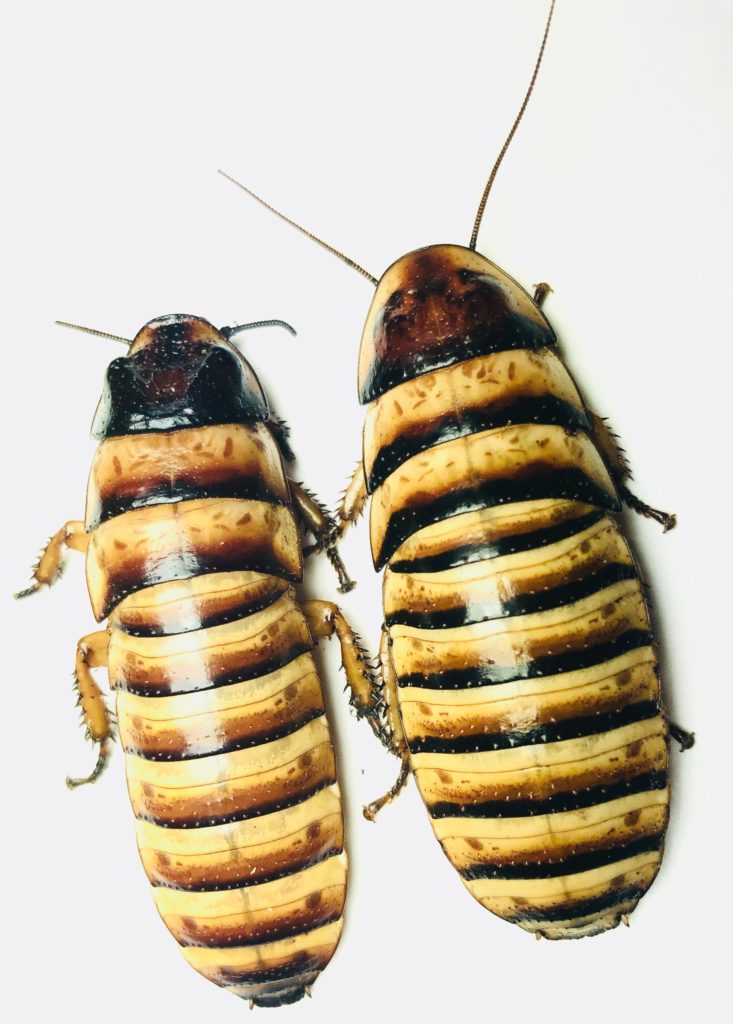
Halloween Hisser (Elliptorhina javanica)
Halloween Hisser Description
Halloween hisser are some of the most handsome and boldly marked of all the hissers. They are dark brown contrasted by cream strips along the abdomen. They are about 1.5-2 inches and tend to be more medium sized as compared to the common hissers. There is said to be two different color forms. One having a red pronotum and the other having a black pronotum. The nymphs start out black and as they mature gain more color until they reach maturity and have the pronounced and familiar color scheme.
Origin
This species like all hissers originate from the islands of Madagascar. Collection data is very vague and secretive. The island is in constant political turmoil and import regulations makes it very difficult for other species to be introduced or new genetics to come in.
Reproduction
Females release pheromones when receptive and mate with select males. Males establish the right to mate by pushing each around using bumpy protrusions on the top of the pronotum. Females produce a long yellow egg case (ootheca) that they retain inside their abdomen for about 60 days. Egg cases contain 30-100 plus eggs. The eggs hatch inside the female and the nymphs are then expelled out. Newly emerged nymphs are pure white until there exoskeleton hardens and darkens. Nymphs crowd around a thick secretion that provides initial sustenance. Sometimes if conditions are not optimal, crowded, or nutrition lacking females may “abort” or expel the partially developed ootheca. Reproduction is inhibited if temperatures are not maintained above 80 degrees.
Development
Nymphs go through a period of 6-7 molts over a period of 6-10 months. Development is largely influenced on temperature as well as nutritional quality. Nymphs often eat some or all of their old shed. If the humidity is not maintained molting problems can occur.
Nutrition
Hissing roaches will eat a wide range of produce, however it should be organic and you should avoid foods that naturally contain phytates and oxalates. I find that feeding hissing roaches organic bananas, oranges, and zucchini works well. I prefer to soak a high protein dog puppy food as the roaches can consume it much easier.
Housing
If you have a small colony they should be housed in a small container. They seem to breed best when kept slightly crowded. This also keeps them in close proximity with their food and water. The media that you place them on should be a mixture of peat and well-rotted compost. The mix should be just barely moist and not soggy. Many people use egg cartons, however I have found that using natural pieces of tree bark stacked toward the back to provide lots of shelter promotes breeding and proper humidity naturally. I like to keep the back half of the tank on the heat mat. I will mist the tank or dump water into the back half were it will naturally evaporate and provide humidity.
Rearing notes
Holloween hissers can rapidly reproduce if they are set up correctly. I have noticed that they tend to breed slower that common hissers, but can prove to be very productive if given a good high protein feed regularly as well as lots of fresh well ripened fruit.
For more information on this species click the link below
http://www.roachcrossing.com/for-sale/roach/all/halloween-hisser/
